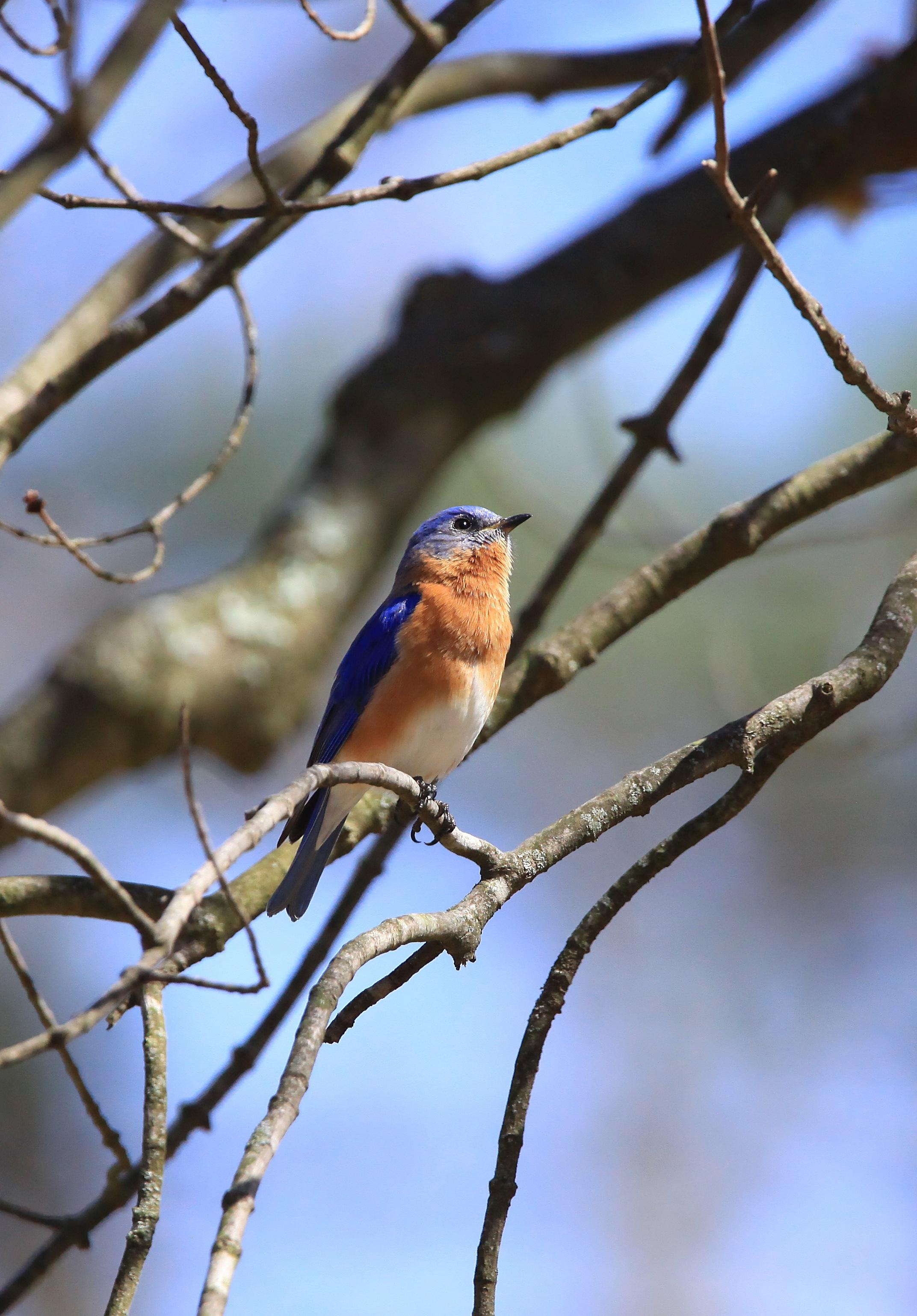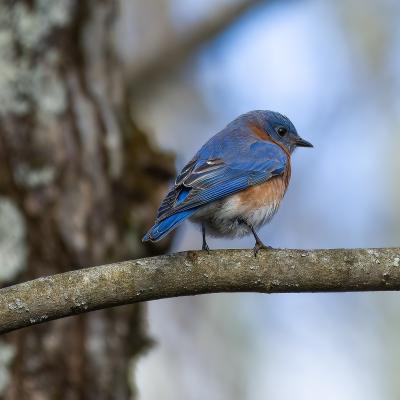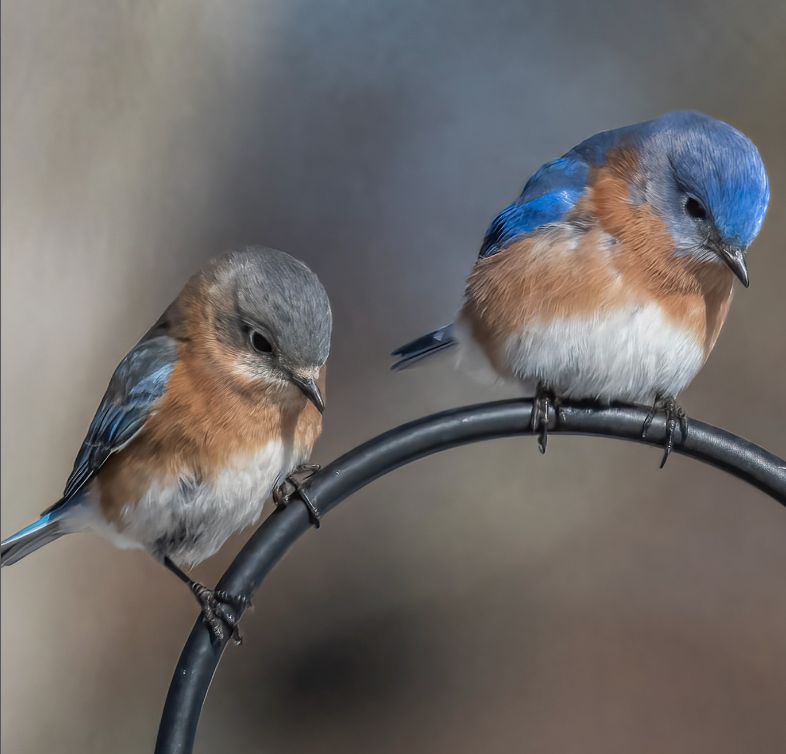Are more Eastern Bluebirds staying for the entire winter in NH?

Bluebirds are widespread across New Hampshire this winter, appearing at bird feeders in central and southern NH for various reasons.
Bluebirds seem to be having a moment. They are widespread across New Hampshire this winter, appearing at bird feeders in central and southern NH for various reasons.
The relatively mild winter temperatures and limited snowfall thus far is part of that story. But also more people have installed nest boxes and are winter-feeding and sharing bluebird photos from backyard birdfeeders to social media channels. They suddenly seem to be everywhere!
Bluebirds favorite winter foods are fat- and protein-rich: peanut hearts, suet, dried mealworms and raisins soaked in hot water. This winter in the Lake Sunapee region, I have watched two pairs from December through January feeding on suet crumbs scattered by woodpeckers hammering the frozen fat. I’ve watched bluebirds perch fluttering on a suet cage to dislodge crumbs when the larger woodpeckers- hairy woodpeckers and red-bellied woodpeckers were not present to assist them.

Bluebird populations are also benefiting from people installing artificial nest boxes. Bluebirds naturally nest inside hollow tree cavities similar to other cavity-nesting winter residents: black-capped chickadees, nuthatches and titmice that are among the most common birds at winter feeders. Bluebirds prefer nest cavities located relatively near the ground at edges of sunny open meadows which provide ample insects, moths and caterpillars during their spring and early summer nesting season. Farmlands, hay fields and orchards provide ideal habitat with the addition of nest boxes. A strategy of nesting in sturdy wooden accommodations allows cavity-nesting birds to remain all winter or arrive earlier in spring than songbirds who travel greater distances from tropical wintering areas and build more exposed nests when insects become available when trees flower at blackfly season in May.
Winter bluebirds on foggy, gray days are harbingers of brighter days and warming sunshine – the blue skies we tend to call “Bluebird Days.”
March Bluebirds
Bluebirds and their thrush cousin, Robins, are both relatively early birds. But it’s hard to characterize “early” when many have lingered since autumn in the same habitats they favor during warmer months. Bluebirds and robins are winter-hardy thrushes that wander widely in response to weather and available food. Some robins nest further north in Canada and migrate south into NH in winter to forage for waxy wetland fruits and berries and remnant crab apples in shopping center and bank parking lots and landscaped backyards. Cold snowy weather drives them further south.

Bluebirds are so-called “facultative migrants,” flexible and responsive to changing conditions that influence the timing of spring and fall migrations. Unlike the “obligate migrants” which are hard-wired to leave and return during a particular season, these partial migrants are becoming more common as erratic winters are becoming shorter and milder.
It’s a risk bluebirds are willing to take in order to be first to claim the best available nest sites. Spring bird migration is always more urgent than autumn. Females prioritize real estate and the earliest males capable of singing to defend the best breeding territories are more successful attracting mates.
The call notes and song of bluebirds are described as a soft, liquid warble. By late winter, pairs of bluebirds are perching near last year’s nest boxes and beginning to show interest. As spring progresses, more aggressive house wrens and tree swallows will claim nest boxes and try to evict early bluebirds. Without intense competition and predation and with ample food, bluebirds may raise two broods of chicks each spring. Now wintering further north nearer their springtime nest boxes ensures a least one brood in late March and perhaps a second brood in May before house wrens or tree swallows outcompete them.
It may be pure speculation on my part but watching bluebirds forage on the ground beneath suet feeders as woodpeckers chisel large crumbs of suet, it seems the warming winters might be abetting bluebirds in other ways.
Large billed red-bellied woodpeckers have only recently expanded their range north to become common across NH. Bluebird pairs at my suet feeders seem to arrive concurrently with these large noisy woodpeckers.
Woodpeckers are primary excavators of cavities in dead and dying trees. Statewide, Emerald Ash Borer beetles are killing swaths of ash trees, laying eggs beneath the bark where the larvae feed in the cambium layer. Warmer winter weather allows more exotic, non-native insects to survive and expand. More tree boring insects yields more dead ash trees. More dead ash trees yields more woodpecker food and cavity nest sites - some of which are later used by secondary cavity species that reuse and renovate woodpecker nest cavities – including bluebirds!
Its all connected, even if we don’t exactly know how – yet.
This article was originally printed in the Union Leader on Feb. 24, 2024.
